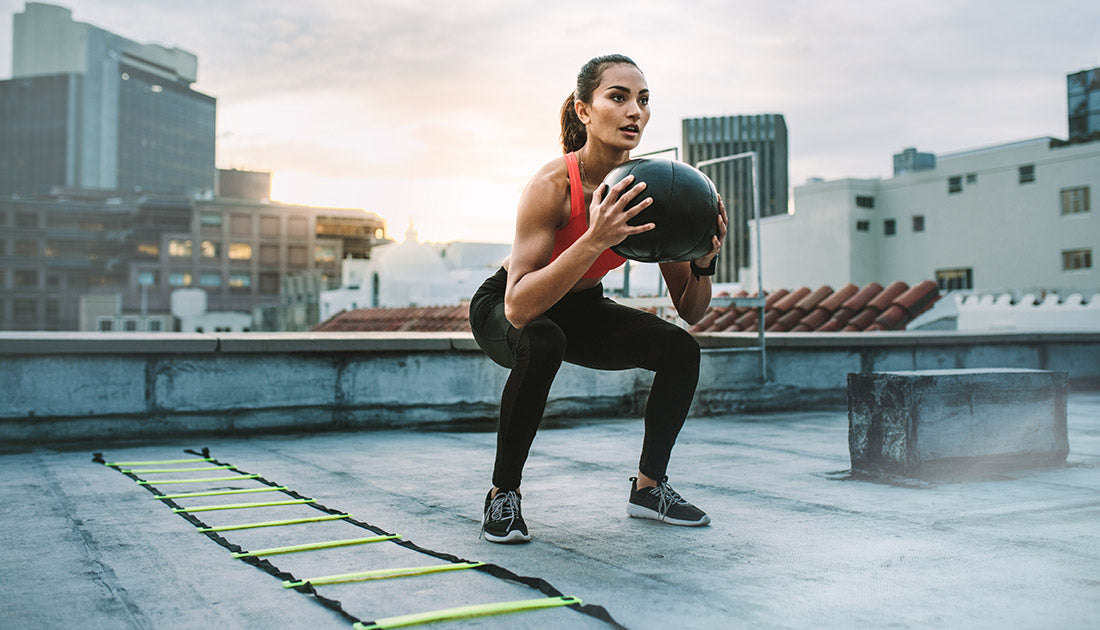Squats are one the most effective exercises for targeting the largest muscle groups of the legs and butt.
Many individuals consider it the "king" of all exercises.
Learn what muscles squats target here and how to take your squat workouts to the next level!
Let’s get started.
Muscles That Squats Work
For an exercise to be considered the "king" of all activities, you would expect that it provides a tremendous amount of bang for your muscle-building buck.
By that, we mean that squats stimulate many muscle fibers in the body, making it an extremely efficient exercise (especially for those who only have a limited time to train).
What's more, the squat can be progressed a seemingly endless number of ways (which we'll get to a bit later), and depending on which squat variation you're performing will determine what muscles you're stimulating more than others.
For instance, wide-stance low-bar squats tend to recruit more of the hips, glutes, and hamstrings, while narrow-stance high-bar squats emphasize more quads and glutes.
Starting with the basic bodyweight squat, the muscles worked include the:
- Quadriceps
- Glutes
- Adductors
- Hamstrings
- Abs
- Calves
It should be mentioned that all the muscles of the lower body will get worked during the squat; which ones are more emphasized (and which regions of those muscles are more heavily taxed) depends on the variation you're performing.
With that in mind, let's now discuss how to perform the squat properly
The Proper Squat Technique
There are dozens and dozens of squat variations you can perform. To explain how to perform each squat variation requires considerable time and detail, which is best saved for a separate article.
For this article, we'll focus on the bodyweight squat.
To perform a basic bodyweight squat, follow these steps:
- Stand up straight with your head up, shoulders pulled down and back, and your feet placed slightly wider than hip-width apart with your toes turned slightly outward.
- Brace your core and begin to bend at the hips and knees, driving your butt straight down between your feet.
- Continue to lower yourself until your thighs break parallel, ensuring that your feet remain planted flat on the floor. Your knee should track over your second toe.
- Pause at the bottom for a second, contract your leg muscles, and push back up to a standing position.
- Repeat for the desired number of reps
How to Enhance Your Squat Workout
Bodyweight squats are an incredibly functional exercise, but they don't offer much in the way of hypertrophy for all but the rank beginners.
Still, that doesn't make them useless. Bodyweight squats can be implemented as part of the warm-up, used as a finisher to burnout the legs at the end of a workout, or as part of an off-day active recovery session.
Here are some of our favorite squat variations and intensification techniques for those looking to progress beyond bodyweight squats and build some impressive quads, glutes, and hamstrings.
Goblet Squats
The goblet squat is the next progression for those looking to advance beyond bodyweight squats and will increase the demand on your leg muscles to help you keep getting results from your workouts.
One of the best aspects of the goblet squat is that it reinforces proper squatting mechanics by forcing you to maintain an upright torso and tight core.
Goblet squats also decrease spinal loading while simultaneously imposing lots of tension on the lower body musculature (which is beneficial for individuals with a history of lower back issues and/or those wary of squatting with a bar on their back).
Goblet squats can be performed using a dumbbell or kettlebell. They are a tremendous squat variation for beginners and early intermediates looking to build strength and reinforce good squatting mechanics. They can also serve as a fantastic "finisher" for more experienced gym rats who have already built a solid base of strength.
Paused Squats
Paused squats are a challenge whether you’re performing them with additional weight or not.
What makes them so challenging is that by pausing in the bottom position of the squat, you're eliminating the stretch reflex of your muscles, which means you're forcing your muscles to work harder (which is excellent if you're trying to increase muscle size and strength)
To perform a paused squat, hang out in the bottom position (while maintaining a whole-body tightness).
In other words, don't relax when you're on hold. Stay tight during your pause, then explode out of the bottom as you typically would.
Pause squats also teach you to "own" the weight you're using, as you can't rely on momentum or the elasticity of your muscles to do the work.
Besides adding weight to your paused squats, another way to make them more challenging is to increase your pauses' length progressively.
For instance:
- Week 1: 1-second pause
- Week 2: 3-second pause
- Week 3: 5-second pause
After performing paused squats for a few weeks, you’ll have gained strength, stability, and power, which translates to better athletic performance, size, and strength.
1-½ Rep Squats
Those of you who are looking for a truly sinister way to make squats even more taxing than they already are, give 1-½ rep squats a try!
The name is pretty self-explanatory:
- Squat down to the bottom position
- Press up halfway
- Lower back down into the bottom position
- Return to the full standing position.
For those playing along at home, that entire sequence is just one rep.
1-½ rep squats (similar to paused squats) increase time under tension, which means your muscles have to do work. This ultimately helps build more muscle and strength.
The 1-½ rep technique can be applied to any exercise (within reason), and it's an excellent option for those who may be training with limited equipment and/or maxed out their current selection of weights as the increased time under tension will make it even lighter loads feel heavy.
Landmine Squats
Landmine squats are yet another outstanding squat variation for gym rats of all levels that helps build strength, muscle, and explosiveness in the lower body. Similar to the goblet squat, landmine squats help reinforce a proper squat pattern since the arc of the barbell naturally travels back, which helps individuals sit down into the squat while maintaining an upright torso.
It's also an excellent alternative for those who can't perform regular squats as well as those who have maxed out their weights with goblet squats. And, it's easier on the joints than back squats or front squats.
To perform landmine squats:
- Begin by putting the unloaded end of the barbell in a landmine apparatus (or stuck in the corner of a room).
- Grab the other end of the barbell and hold it in a goblet position against your chest.
- Squat down until your thighs are at least parallel to the floor. (Similar to goblet squats, your elbows should be dropping inside your knees, depending on the width of your stance).
- Pause in the hole for a count of one, then forcefully squeeze your leg muscles to power back up to a standing position.
Takeaway
Squats are one of the most effective exercises that can help you build muscle and strength in your lower body. You can perform dozens of different squat variations depending on your level of skill, power, and equipment availability, which makes the squat incredibly accessible as it can be performed anywhere with or without equipment.
Maintaining good form is essential because it's easy to do them incorrectly (as is the case with most exercises), leading to potential injury.
Use the tips and variations outlined above to spice up your squat work out and get better results from your time spent in the gym!
And, if you need some added energy, focus, and motivation to make it through a challenging squat workout, check out Steel Pump®.
Steel Pump® is a delicious-tasting pre-workout supplement formulated to help you train harder and longer while reducing fatigue and muscle damage. Every serving of Steel Pump® provides research-backed ingredients, including citrulline, beta-alanine, and PeakATP, to help you make the most of your time spent in the gym!

